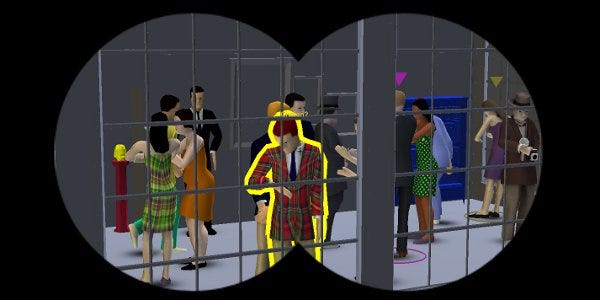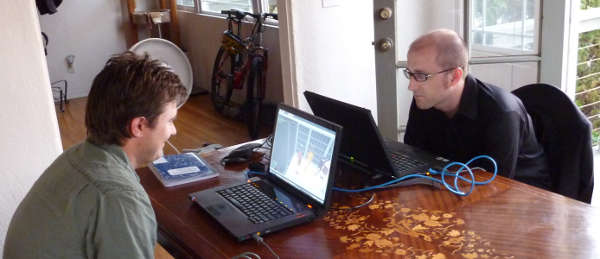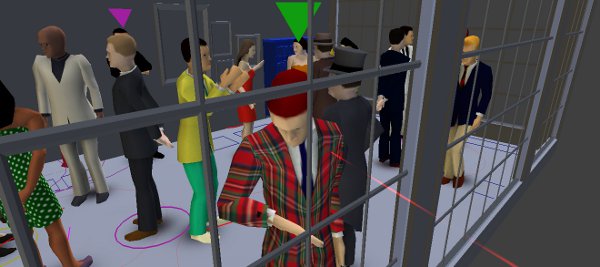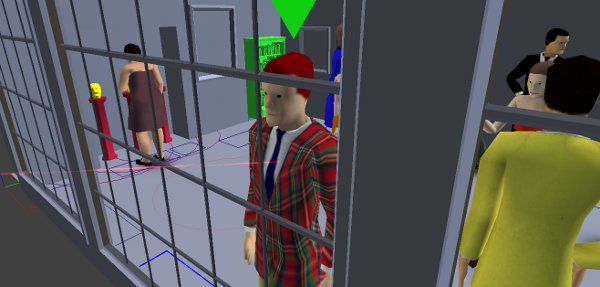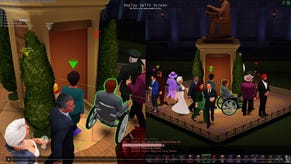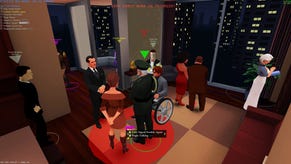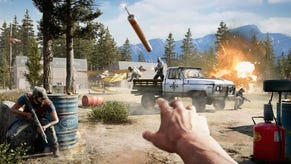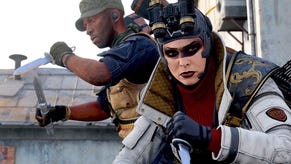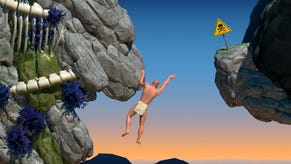Spy Party Hard: Hands On With Spy Party
Andy “Monaco” Schatz's cat is being slowly broiled alive. It crawled behind the oven, which was in the process of cooking Macaroni & Cheese. It's only later that Andy's Delightful Wife is alerted by the frantic yelping of a distressed pussycat. We're about to play SpyParty at my hotel room when the alert comes through, leading to a frantic cross-San Diego dash to try and rescue the pipping-hot cat from its furnace-crammed state. The Andy is trying to get his landlord on the phone, to see if there's any reason why they can't just pull the oven around. He's failed. Meanwhile, Spy-Party-dev Chris Hecker is insisting that it'll be fine, and we should just act immediately heft the cooker to release it. Let's do this thing! We do this thing, and the cat runs free.
I'm not sure this is a metaphor about Chris's position in the industry or SpyParty or how he's a man capable of making hard decisions swiftly, but it was too good not to share. And I wanted something to separate this initial report of SpyParty from all the other pieces online, because I'm basically going to echo what they all said. This is looking like something genuinely startling.
The concept of SpyParty is simple. It's a competitive two-player game. One person plays a spy, trying to perform a series of missions at a party. For example, bugging the ambassador, moving books around and similar. The other person plays a sniper, lurking outside the room, who is trying to shoot the spy. The problem being, the sniper's only got a single bullet. Thus the game becomes one of deduction and stealth. The Spy has to merge convincingly in with the other AI members at the party. The Sniper has to look out for clues which reveal them AND THEN SHOOT THEM WITH MIGHTY GUN-BULLET. It's a particularly clever solution to the issue of game AI. Rather than worrying too much about making real AI, it's a game where the player has to copy the AI. It's basically a reverse Turing test. Can you convince the other player that you're not a human, but a machine.
Playing four games against the similar Spy-Party-virgin Andy Schatz, and I can confirm it's a uniquely tense experience, which flips dramatically depends on whether you're the Spy or the Sniper. Also, my time with it negates my main worry – that the idea is sharp enough that he'd be better doing it quickly rather than spending at least another year on it. I suspected its audience size is relatively marginal, so spending all that time wouldn't actually pay off for him in cold commercial terms. The extra year to make it slick, accessible and graphically neat is overkill. The core thing is the core thing. Roll with that, and profit from the players willing to make the leap with you.
But I suspect SpyParty could get a surprisingly wide audience. It's simultaneously a high-player-skill game where you're able to strive towards excellence and - even in its current state – accessible even to players who'd struggle to wrestle with complicated controls. The sniper moves on a track around the level, zooming in and out. The player controls a single character, with all its interactions being contextual.
That it's pleasures are pretty much unique's just the cherry on top.
What's most initially striking is how the asymmetrical nature of the game really makes each side its own experience. The Spy is a game with a mass of options, with you able to interact with all the objects in the game and able to mimic the actions of the other AI-controlled actors. Always, the question is “what should I do now?”. Your decisions are second by second, reading the situation as best you can. The Sniper is the more passive role. You can't in the current game do anything to the world, with your interaction limited to moving around the room for a better angle, zooming in and generally watching for Spy-stuff. And watching stuff is the thing. The Spy at least always has a clue of what they're doing. The Sniper is primarily a reactive role, trying to process the mass of information from all the people milling around the room. What is noise? What is signal? And is it a good enough signal to be shot through head?
I personally find the Sniper position by far the most stressful, though Hecker notes that it's something which seems to basically depend on someone's personality type. That you're taking a lead as a Spy at least means you have agency. You know what you're doing. The nagging noise in my head as I play Sniper is “What am I missing? What's happening before me?”. And it strikes me a little like a penalty shoot-out, with the sniper as the player taking the shot and the Spy as the goalie. People expect the Spy to fail, because the task is enormous and you could give yourself away with a single mis-step. The Sniper has only one mistake to make... which ends the game. You mainly win the game by spotting that the Spy has made a mistake.
And as two new players, we make some glorious mistakes. In the final game, I give myself away to Andy by stopping a half-step before I reach the actual statue I'm trying to pick up and examine. I simply misjudged the distance, falling short and doing what an AI wouldn't do. The bullet follows a second later.
This is actually an interesting example of how the simple controls actually mean there's room for high player skill to develop. It's not a game where it's going to be generous to you in that way and cover the gaps. It wants you to cover the gaps. Hecker wants to make sure the core game is deep enough to lead to the sort of serious competitive play that more traditional shooter games have – and that's absolutely what he's concentrating on now.
(And this is, for the record, what actually makes me think the extra year and change is ideal for the game. It's going to have much more stuff than the high-concept idea, from mission types upwards. Training sequences where novice players are introduced a concept at a time should also ease people in – for example, something as simple as just finding the character with a red-rose on the lapel starts increasing your awareness of the whole level.)
He's going to make a deep game and then work out how to make it more accessible later . As a veteran of the Spore team, he thinks that's the mistake that team made was trying to do it the other way around. He doesn't want to do that again. At the worst, he's just going to make a totally different mistake.
It must be said, I don't think he's making a mistake.
One example of the skill-increasing elements he's working on is a reapproproation of the Gears of War active-re-load system into the Spy's interactions. So, when planting a bug on the ambassador, you'll have the option of a golf-game-esque timing test. Nail it, and you'll do an incredibly subtle bugging gesture. Screw it up, and it'll be a hyper-obvious pratt-fall. And if you think the sniper isn't watching, you can just not play the game and get a standard bug-planting.
He's also working on other options for the Sniper. For example, there's a security guard in the room who the Sniper can order to go and interrogate one of the guests, asking questions which they'll answer. There's a spanner in the works here too, as the Spy chooses who at the party they wish to play – and they can play the Security Guard, meaning they'll be messaged orders from the Spy, which they then have to obey.
Then there's the security camera watching the room. This can be set to either record or watch by the sniper. If it's recording, it records what it sees. If it's watching, the Sniper gets to examine it. However, the light on the camera will switch on and off depending on what task is going. That means that the Spy is able to know when the Sniper is examining the tapes, allowing them to make a daring move. And, of course, just because the Sniper's set the camera to “watch” doesn't mean that they're actually watching it. It could all be a ruse. It's that sort of game.
The simple choice of which character the Spy select to be is a fine example of how SpyParty gets gameplay from the most basic of its elements. If someone played someone last time, surely they won't pick that black guy with the awesome Saturday Night Fever suit again? Or will they? You can read people's personality in their choices. For example, if I was playing Walker, I'd just shoot the sensitive girl character as soon as we start playing. Playing in the same room leads to all manner of out of game elements here too. I start mocking the character in plaid – who's my main suspect. If I actually was looking at Andy, I suspect the fact I was right would be all over his face.
There's also the hint of the future for Chris. Part of the game which is coming has to be AI characters who display these emotional states. This is the sort of technology which is pretty much limited to Maxis studios, meaning that SpyParty could be a stepping stone to the sort of emotion-centric games Chris thinks the industry should pursue. Chris has been playing in a debug mode when you have infinite bullets, and was amused to find that actually just playing it that way was a whole load of fun... but immediately backed away. He says that we already know that firing hundreds of bullets is fun. Let's find out what else is. I can only agree, and await the finished version of SpyParty with unbecoming eagerness.
You can follow SpyParty's development at its site.
